#Hapi (Nile god)
Text

hapi, intersex god of nile flooding (digital, 2024)
#digital art#naive art#primitivism#weird art#furry#furry art#sfw furry#hapi#egyptian myth#egyptian mythology#egyptian myths#egyptian gods#kemetic paganism#kemeticism#kemetic#nile river#nile#hippo#fish#frog#intersex#trans
49 notes
·
View notes
Text
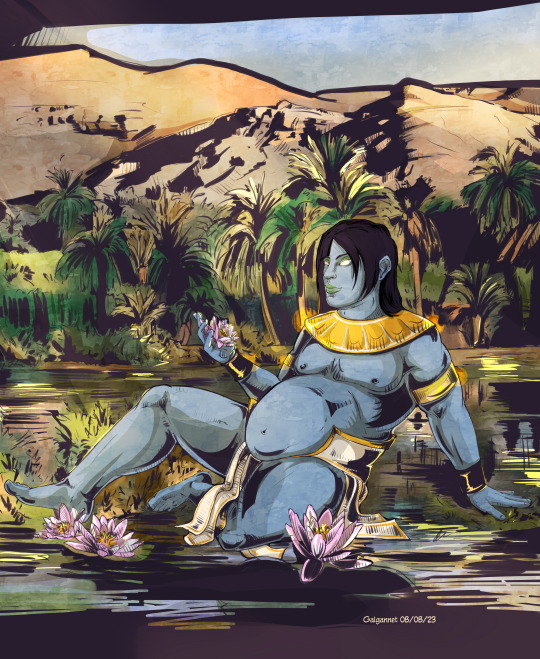
Lord Hapi (God of the Nile)
Hapi, the Egyptian god of fertility, water and associated with the rich black mud called silt, featured in the stories, myths and legends in Egyptian Mythology. Hapi was believed to live in caves near the Nile cataract (white water rapids) which was on the border between Egypt and Nubia. The economy of ancient Egypt relied on its agricultural wealth and, therefore, on the River Nile. Every year a torrent of water overflowed on to the banks of the River Nile leaving a thick rich mud (called black silt) and alluvial soil that fertilized the land. The Nile god Hapi was believed to bring the silt to the banks of the Nile, making farming possible surrounding the banks of the River Nile, an otherwise desert region.
Artstation | Deviantart | VK | Commission List
#NoAI#Ancient Egypt#gods of egypt#Egyptian gods#Hapi (Nile god)#Hapi#Digital 2D#Nile god#Illustration#comic book style#comic art#comic style
57 notes
·
View notes
Photo



Gods of Egypt (part 1)
Ra
Hapi (Nile god)
Khepri
#Gods of Egypt#ancient Egyptian religion#egyptian gods#scarab#Sun disk#shadow theater#shadow play#Ra#Khepri#Hapi#Nile god#Ра#Хапи#Хепри#боги египта#Ancient Egypt
44 notes
·
View notes
Photo


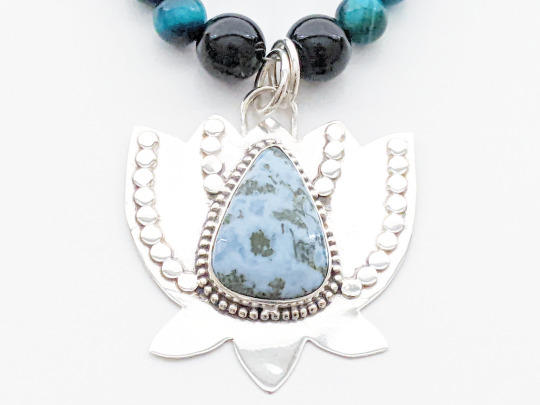

EGYPTIAN GOD HAPI DEVOTIONAL NECKLACE
https://www.etsy.com/listing/1435825079/egyptian-god-hapi-devotional-necklace
Blue Howlite dyed gemstone beads, Mystic Blue-Green Tiger’s Eye color-enhanced gemstone beads, with a Silver and Owyhee Opal Lotus Pendant, faceted Black Agate end pieces and accents, and a Silver-Colored Metal lobster clasp closure
*Commissions are Open!*
Reblogging is welcome! <3
#Kemetic#Kemeticism#Pagan#Kemetic Fandom#Kemetic Orthodox#Egyptian Gods#Egyptian Mythology#Egyptology#Ancient Egypt#Hapi#Hapi God#Hapi Deity#God of the Nile#Water God#Father God#Fertility God#Queer God#Divine Masculine#Wicca#Wiccan#Witchcraft#Kemetic Jewelry#Pagan Jewelry#Egyptian Jewelry#Kemetic Prayer Beads#Devotional Jewelry
9 notes
·
View notes
Text
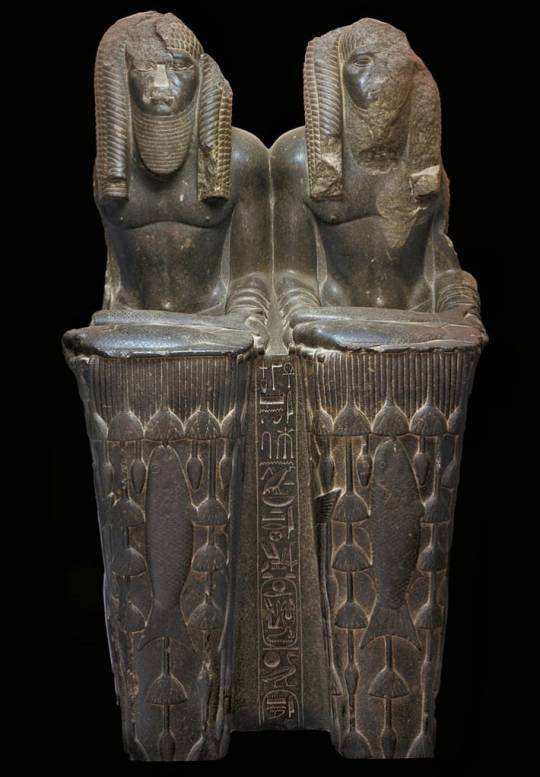
Statue of Amenemhat III as Hapi
This double statue of Amenemhat III as Hapi, the Nile god, was discovered at Tanis, capital of the 21st Dynasty Kings, however, the two male figures are clearly portraits of the 12th Dynasty king Amenemhat III.
They are carved with perfect symmetry, offering fish, birds, and aquatic plants. Both wear heavy wigs with large braids, wide beards, and finely pleated kilts. This representation of the king as Hapi is a novelty in royal statuary.
Middle Kingdom, 12th Dynasty, reign of Amenemhat III, ca. 1860-1814 BC. Now in the Egyptian Museum, Cairo. JE 18221
Read more
291 notes
·
View notes
Text

Character for an MHA/BNHA-themed DND campaign.
Their name is Hapi (after the nonbinary god of the flooding Nile), and their quirk is the plagues of Egypt, but they can only use them in order and can't really control them yet.
Don't let them get to the 10th plague.
#dnd#dungeons and dragons#mha#bnha#ttrpg#oc#original character#art#digital art#illustration#circe draws
77 notes
·
View notes
Text
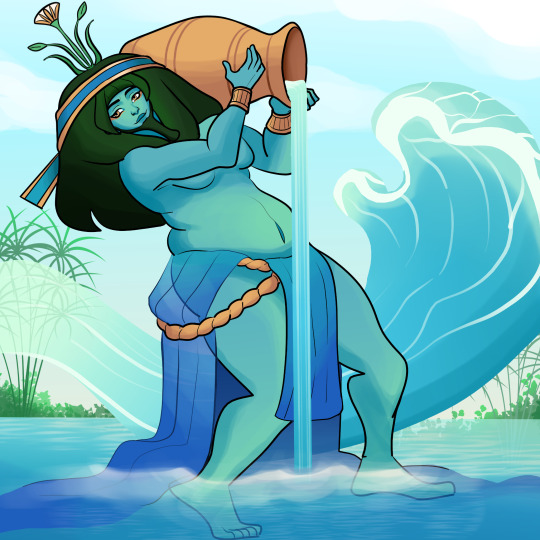

Hapi, the generous God of the Nile is the main responsible of the annual flood of the sacred river that makes Kemet one of the most fertile soils on Earth. However, their blessings do come with a price, and it is often related to the conduct of the people and on how worthy one Pharaoh's reign can be, based on this God's own judgment. Hapi is a kind but very introverted deity whose genuine smiles can warm anyone's heart, however they prefer to linger in isolated and pacific places where they can rest and prepare themselves for the annual flood.
66 notes
·
View notes
Text
(Jjsheh. This is perhaps my most unhinged essay yet, brace yourselves. I know it's not very coherent, I sound like I'm tripping, rambling about ancient Egyptian deities and all. I'm not the only one to have talked of rebirth though so hopefully I'm not alone in this mental collapse.)
I'm a wreck. It's just such BLATANT BUDDIE SUBTEXT to air THESE SCENES in the same episode!!!!
First, Eddie finding out Buck went on a date with a man and his stunned
"Omg I need to reconstruct my entire worldview. But I'm not weirded out!! I'm an ALLY!!"-deer in the headlights reaction to that!!

Finding out that both Buck and Tommy are into men will be such a curveball for Eddie, hitting him directly in the solar plexus, leaving him gasping.
The images that will start sprouting in his mind...





And the way that suddenly they're BOTH stumbling in this gigantic maze of confusion and questioning, looking at each other anew...
realising they need to reconstruct their entire worldviews because all of a sudden... They've been shattered.
The way that Buck looks at Eddie...?


The mirrored MASKS that both of these lines are!!


Starting to realise their worlds are in ashes.
Then rebirth.
Phoenix rising!!!
It's that treasure hunt riddle again.I've tried to figure it out and the way I read it, I think it's about feelings realization.
The "Narrow place" in the riddle sounds like an obvious arrow to Egypt. That's what the hebrew people called it or something, due to the divisional geography/the stories about them being enslaved there. Something like that.
And of course the river's edge in the riddle would then be The Nile. Denial.
And that heron? The ancient egyptian version of a Phoenix, Bennu. The deity of sun, creation, rebirth.
And what's a secret treasure by denial's edge? It's love. A secret treasure. Precious, yet something you want to hide. Hidden. Buried.
And the bullfrog is a reference to a line in a song, I think. "Jeremiah was a bullfrog".
Originally the line was supposed to be "Jeremiah was a prophet". The assistant in the episode, who was asked to hide the treasure... is called Jeremiah.
Jeremiah, the prophet, according to the Bible apparently traveled to Egypt himself.
But in the treasure hunt episode he steals the treasure and takes off to Maledives - an island without river's, btw!! No DeNial there!
Also... Another link to Egypt/Denial is the bullfrog croaking good measure.
"Ancient Egyptians used weights, like this small frog, to help calculate the value of goods. One Ancient Egyptian unit of measurement was the qedet, equivalent to about nine grams. "
"The Ancient Egyptians linked frogs to fertility and rebirth, likely because of the animal’s prolific reproduction.
These ties to abundance may have made frogs a suitable form for objects used to determine value."
Secret treasure, frogs, measurement, value, herons, narrow place = Egypt, the river's edge... (& My loss of sanity) Lots of links.
So let's see.
I walked along the river's Denial's edge
To hide my secret treasure love
The heron phoenix soared (= I burned, I was reborn.)
The gray bridge roared I saw you. (Because the bridge would be a reference to the "I see you!!" scene with Lola and Norman on that bridge, I think?)
And
"Isn't that what we all want in a partner, to be seen?"
I stopped beneath the willow tree
In the narrow place
And saw a light beam fall upon my treasured place hidden love
The light beam... It think it's truth? Realization, rebirth...
Btw, in the Bible Jeremiah writes about willow trees with much passion. It symbolizes hope, will grow by the river even in times of draught. So trust the Lord (the showmakers).
Also, this recent data of Marisol being nunlike?? What's "Nun" in relation to the Egypt theme?
Nun was represented as a frog or a frog-headed man (as a member of the Ogdoad) but could also be depicted as a bearded man with blue or green skin (reflecting his link with the river Nile and fertility).
In the latter form he can look fairly similar to Hapi (LOL), the god of the Nile, and often appears either standing on a solar boat or rising from the waters holding a palm frond (a symbol of long life), Occasionally, he appears as a hermaphrodite with pronounced breasts.
Nu ("Watery One") or Nun ("The Inert One") (Ancient Egyptian: nnw Nānaw; Coptic: Ⲛⲟⲩⲛ Noun), in ancient Egyptian religion, is the personification of the primordial watery abyss which existed at the time of creation and from which the creator sun god Ra arose.[1]
So let's watch the sun, rising from the denial!
#buddie#911 buddie#eddie diaz#evan buckley#buddie 911#evan buck buckley#911 on abc#911 abc#tv: 911#eddie díaz#911 treasure hunt#911 spoilers#911 speculation#I am not the gif wizard#911 treasure hunt riddle
28 notes
·
View notes
Text
i don’t usually talk about my private life unless it interferes with my writing or maybe inspires it, but i wanted to share something with you all. i talk a lot—because i want you to understand—so i will put this under a read more
well, it’s been a tumultuous two or so years since moving with my parents to this beach town in CA. some very good, some incredibly bad. and… it’s coming to an end. it’s a very complicated story and i suppose i don’t really want to share all the details, but i think i will share the big parts
like most people i have a complicated relationship with my parents. they are very kind but they also have done some irreparable damage to my psyche, like a lot of parents do. and maybe irreparable is the wrong word because i do forgive them, but regardless i will be moving out of this home without their knowledge.
i tried to do it once and i got caught. who i thought was my best friend decided to tell my parents and i got yelled at and berated for weeks, and my dreams crushed. i was going to go to egypt. i was going to go with my partner, my soul partner, who lived in another country. don’t worry, i met her in real life first while i was traveling. but.. i was going to go to egypt! the land of my Deities! my beautiful Gods Nefertem and Nuit, Hapy, Heka, Khonsu, and Amun… all of Them. Their beautiful faces. carved in the stone of Kemet. my parents never would have let me go but i was ready, i was willing, i would give up anything i own to be there in egypt with my Gods and my love. and then my friend, who was living in my room since he didn’t want to live with his parents, told my secret and nearly had my passport taken away permanently. he left my house and i can’t talk to him anymore because i won’t. can’t stand his words or his voice. but i forgive him.. i just don’t want to communicate with him anymore. i wish him the best.
i travelled to my ancestral homeland of korea after the separation and heartbreak. i visited many Buddhist temples and learned and engrained myself more with the act of worship and the Buddhas teachings; i fell in love with worshipping. i fell in love with the temples. and i revisited the ideas i’d learned in the sixth grade—idea of giving things up. of releasing material want, which leads to the cessation of dukkha. the idea is beautiful. and i think it’s accurate. stopping our desires for material things of this world will stop our suffering; suffering emanates from our greed. fear emanates from greed. in the end what matters is our connections to people, and in this case, my connection to my Love and my Deities. in korea, i found the knowledge, independence, and courage that has allowed me to bring to realization what i want not from this world, but from my life.
and now i’m trying again. i’m telling no one of my plan. actually, two people know—one is my closest friend of eight years who lives five hours north of me. another is someone i vetted thoroughly to confirm his ideology and make sure he wouldn’t tell my parents. and actually, he supports me! he almost admires my decision, the courage to get what you want despite the odds. and he is helping me. he’s a blessing from Hathor, an aid of Khonsu to help me travel to the airport to see my Love and my holy land.
there is no greater excitement than this! i will be able to feel the Nile through my feet and hands and hair. and the light of Amun-Re and Khons will shine on my face. and my love will hold my hand. does it seem like a fantasy? well, the world is love, the world is hate… the world is what you make of it. i know people who have easy lives and are incredibly depressed. and there is my Love, who has had an incredibly hard life and will talk much about it, but she is incredibly happy. she is enlightened. i want to be like her—i want to be with her.
do i sound insane? probably. but i’ve learned being crazy is a good thing. especially for writers. i don’t know how many more stories i will write about our beloved Ahkmenrah. i still have the Breeding Kings to finish as well as the Night Grows Dim. then i have a story i want to write about Nabataeans, and i might write a long forgotten story i used to call Hiding in the Light. i hope i will get published some day but it’s not my greatest desire. my greatest desire is to see the world with unending clarity, to know things as they truly are; in other words, to be enlightened. to worship my Deities. this is my path towards that.
to put it in perspective, i have two paths. literally two. i can follow what my parents ask of me; go to college, get a job, work for a long while, and then i can travel when i happen to get free time once a year for one or two weeks at a time. i can settle down in america without my Love; she is already a refugee in israel and can’t move to america. so i would be alone. this path has its good parts. my parents will love me, so will my grandparents. i’ll be well-off with many physical belongings tying me to this realm (which is debatably good thing—bad thing in my eyes), and i will be a normal person. how delightful.
the other path is the one i am choosing. i am going to follow my dreams, which is a terrifying thing to hear a 19 year old say. but i didn’t even think i’d live this long. i’ve healed so much. and this will further my healing. i wonder if it is possible for you to understand… maybe not. it’s difficult to comprehend. but i want you to know. i want you to understand. and it’s not because i want you to know what’s going on (though i do of course), actually it’s selfish, because i want to be understood, very desperately i want to be understood because no one except my friend who is driving me to the airport understands me. and even he is a little on the edge with it despite fully supporting me. this feeling of desire to be understood fades slowly from my life, little by little. i come to realize—or perhaps question—is it worth it? most people are incredibly close minded. most people live their lives blind to happiness and the truth of the world. most people do not even care about themselves. and i do not want to end up like that. that is not the future i’ve worked so hard to heal myself for.
everything will go. and all will change.
someday i will die. someday my love will die. someday all my possessions will be dust. someday this land will erupt in lava or sink into the crevices of earthquakes, or maybe it will slowly fade into the ocean. someday this earth will be unrecognizable. someday, our home will not seem like our home at all, and the only indication that we ever existed will be stones in the shape of our skeletons, and maybe even those will not exist. and someday the earth will be gone. our sun will implode, and the black love of space will enshroud everything. at that point, i really don’t want to be walking around talking about how i went to college. i don’t even want to be talking about how i managed to run away from america and go to egypt.
i want to be learned. i want to see it all in its beauty as the earth dies in its many wondrous colors—i want to smile as the sun evaporates into particles of gold, i want to understand this cycle and it’s end. and the way to get here—to this sense of bliss and enlightenment—is to separate from what the modern world wants me to be.
listen to me very well, because no one ever really does this—you have to live.
please live. this word carries weight like love; which means that not many understand it’s depth. you know it’s definition. but the meaning of it is indescribable and beautiful like a supernova the size of a galaxy.
You have to love. You have to live. Please.
28 notes
·
View notes
Text






Hapi
Major cult center:Elephantine
Symbols:Amphora 𓎿 𓏂, Fertility, Hippopotamus, Lotus and Crocodiles (Upper Egypt), Papyrus plants and attended by frogs (Lower Egypt), Nile, Water
Connection to other gods:Geb (God of the earth), Neper (God of grain)
Priest names
(roles) priests were involved in rituals to ensure the steady levels of flow required from the annual flood. Located at Ta-Sety, Abu/Elephantine there was nilometer, a measuring device, was carefully monitored to predict the level of the flood, and his priests must have been intimately concerned with its monitoring.
Features
Hapy is show as an intersex person with a large belly and pendulous breasts, wearing a loincloth and ceremonial false beard. He is depicted with either blue or green skin, representing water. In Lower Egypt, he was adorned with papyrus plants and attended by frogs. In Upper Egypt, it was the lotus and crocodiles which were more present in the Nile. He is often pictured carrying offerings of food or pouring water from an amphora, but also, very rarely, was depicted as a hippopotamus. During the Nineteenth dynasty Hapy is often depicted as a pair of figures, each holding and tying together the long stem of two plants representing Upper and Lower Egypt, symbolically binding the two halves of the country around a hieroglyph meaning "union". Not to be confused with one of Horu's son Hapi by the same name.
Hapi (Ancient Egyptian: ḥʿpy) was the god of the annual flooding of the Nile in ancient Egyptian religion. The flood deposited rich silt (fertile soil) on the river's banks, allowing the Egyptians to grow crops. Hapi was greatly celebrated among the Egyptians. Some of the titles of Hapi were "Lord of the Fish and Birds of the Marshes" and "Lord of the River Bringing Vegetation". Hapi is typically depicted as an androgynous figure with a prominent belly and large drooping breasts, wearing a loincloth and ceremonial false beard.
Mythology
The annual flooding of the Nile occasionally was said to be the Arrival of Hapi. Since this flooding provided fertile soil in an area that was otherwise desert, Hapi symbolised fertility. He had large female breasts because he was said to bring a rich and nourishing harvest. Due to his fertile nature he was sometimes considered the "father of the gods",and was considered to be a caring father who helped to maintain the balance of the cosmos, the world or universe regarded as an orderly, harmonious system. He was thought to live within a cavern at the supposed source of the Nile near Aswan. The cult of Hapi was mainly located at the First Cataract named Elephantine. His priests were involved in rituals to ensure the steady levels of flow required from the annual flood. At Elephantine the official nilometer, a measuring device, was carefully monitored to predict the level of the flood, and his priests must have been intimately concerned with its monitoring.
Hapi was not regarded as the god of the Nile itself but of the inundation event. He was also considered a "friend of Geb", the Egyptian god of the earth, and the "lord of Neper", the god of grain.
Roles
Hapi is an intersexed god, who is probably shown this way to represent the fertility of the nile's annual flood. He is not considered the God of the Nile , but represent the annual flooding of the Nile and inundation event called the Arrival of Hapi. Hapi maintain the balance of the cosmos. He was sometimes considered the Father of the Gods because of his fertile.
Iconography
Although male and wearing the false beard, Hapi was pictured with pendulous breasts and a large stomach, as representations of the fertility of the Nile. He also was usually given blue or green skin, representing water. Other attributes varied, depending upon the region of Egypt in which the depictions exist. In Lower Egypt, he was adorned with papyrus plants and attended by frogs, present in the region, and symbols of it. Whereas in Upper Egypt, it was the lotus and crocodiles which were more present in the Nile, thus these were the symbols of the region, and those associated with Hapi there. Hapi often was pictured carrying offerings of food or pouring water from an amphora, but also, very rarely, was depicted as a hippopotamus. During the Nineteenth Dynasty Hapi is often depicted as a pair of figures, each holding and tying together the long stem of two plants representing Upper and Lower Egypt, symbolically binding the two halves of the country around a hieroglyph meaning "union".This symbolic representation was often carved at the base of seated statues of the pharaoh.[ Egyptian historian Al Maqrizi (1364–1442) related in his "El Khutat El Maqrizia (The Maqrizian Plans) that living virgins were sacrificed annually as "brides of the Nile" ("Arous El Nil") and this has been historically accepted as late as the 1970s. but this claim is disputed by some Egyptologists such as Bassam El Shammaa.
──────⊰In Workings⊱──────
*Please know basic protections and energy work before attempting any deity work.*
*It is important to note that everyone's experiences are different and will work with spirits for different reasons. Some people may like a spirit while others will not and that's okay. Ask these spirits what they will work with you on as well as ask them if they can help you with whatever it is you need.*
Ideas for honoring or working with/worshipping Hapi
Altar
Create an altar/sacred space for your rituals and giving offerings for Hapi. Items may include
⬩An altar cloth
⬩Blue candles (you can use any color)
⬩Cup or chalice
⬩Incense and an incense burner
⬩Offering bowl
⬩Statue of Hapi
For more information on basic deity work and altar setups check out the deity work post.
Basic offerings:Bread, Frankincense, Game Meat, Lion Statue Myrrh, Sour Dough, Meat, Sun Symbols,
Ritual
Ideas for rituals may include
⬩Fertility rites
⬩Maintaining balance
⬩Maintaining steady levels from the flood
⬩Ask him what else he can help you on⬩
The Hymn to the Flood
Lightmaker who comes from the dark Fattener of herds Might that fashions all None can live without him People are clothed with the flax of his fieldsThou makest all the land to drink unceasingly, as thou descendest on thy way from the heavens.
𓈖𓈖𓈖𓈖𓈖𓈖𓈖𓈖𓈖𓈖𓈖𓈖𓈖𓈖𓈖𓈖𓈖

For more content relating to other practices/religions or pantheons follow my main blog for updates
If you have any more questions or wish to join a community feel free to join my 18+ discord server
Ask me anything on my blog
#Hapi#kemetism#occult#witchcraft#witchblr#deity#pagan#paganism#Kemeticism#neterism#neter#netjer#neteru#netjeru#kemetic#kemetic pagan#kemetic paganism#kemetic polytheism#kemetic witch#pagan witch#witch#baby witch#baby pagan#occultism#occultblr#paganblr#kemetblr
20 notes
·
View notes
Text

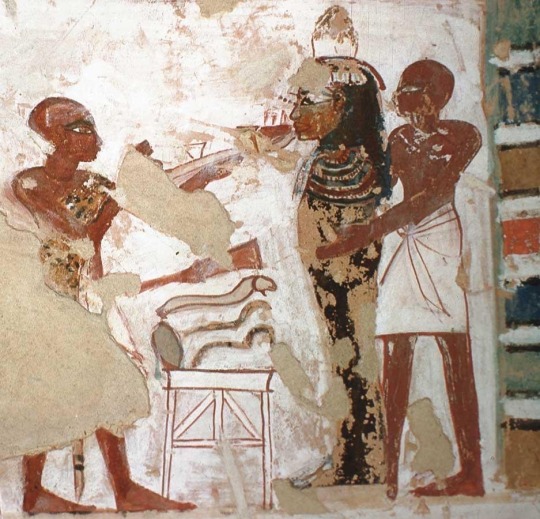
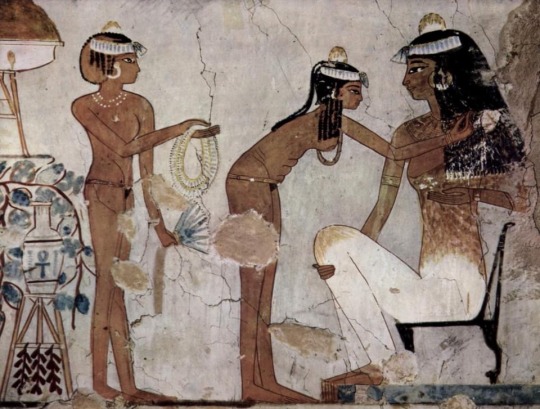
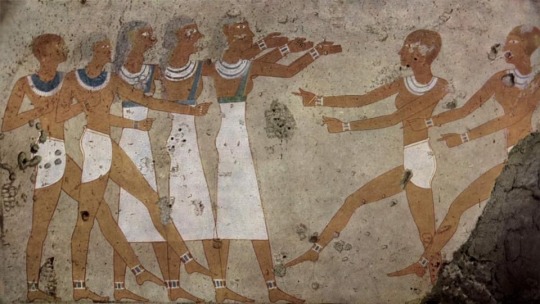




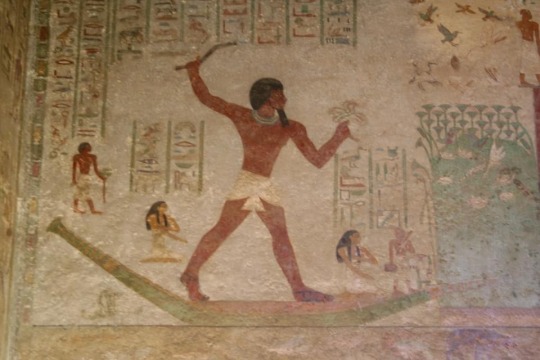

THE GREAT WA-SETIANS & KINGS TOMBS OF WASET (Theban Tombs)
The Wasetians, Known to the Greeks, and modern Egyptians as Thebans (not to be confused with Greek Thebans) originated in the southernmost regions of Kemet, known as Ta-Shemau "the Land of Reeds”. Waset was the main city of the fourth Upper Kemetic nome and was the capital of Kemet for long periods during the Middle Kingdom and New Kingdom eras.
In antiquity Waset was known as a prominent city and royal house whose residents were dedicated to the worship of Amun. He was chief of the Wa-Setian Triad of deities whose other members were Mut and Khonsu. Amun’s primordial birthplace is located in Nubia at the holy mountain of Gebel Barkal. Waset served as a testimony not only to Kemetic life but also to the pinnacle of Hapi (Nile) Valley civilization. The Greeks would refer to the city as Diospolis Magna ('The Great City of the Gods'). The Greek Poet Homer once wrote about the majesty of Waset, labeling it a place where “heaps of precious ingots gleam.”
Over the centuries the Wa-Setian Kings from the south battled for control over Lower Kemet with invading forces from the near east. The reunification of the nation under Mentuhotep II ushered in a new sense of security throughout the country and established Kemet’s Middle Kingdom, an era that was to become a golden age for artistic and literary creation and a truly revolutionary period in regard to religion and royal ideology.
But during the reign of Amenemhat IV, a local ruler in Lower Kemet of foreign origin became more and more powerful. It is during this reign that the frequent expeditions into the Sinai came to a stop, probably because the expeditions had to go via the Delta. Towards the end of the reign of Nefrusobek, this foreign ruler was able to found his own dynasty, the 14th, which, ruling from the city of Avaris, controlled the eastern Delta, and perhaps all of Lower Kemet.
For a time Waset was a wealthy city under the rule of the Kemetic Empire but was later sacked by Assyrians, Persians, Romans, and later by the Arabs. Their destruction is illustrated in the Wa-Setian (Theban) Tombs list, as most of the statues and steles of these Southern Kings and Queens have been erased from history. It’s hard to believe that anything could survive several generations of destruction, but Waset has. The Wasetian Tombs known today as the Theban tombs were for the most part destroyed and over the years have been overshadowed by the Valley of the Kings. Remanence of the temples and tombs still remain as well as the Temple of Amun at Waset (Karnak), the tomb of Tutankhamen in the Valley of the Kings, and mortuary temples of Ramses II and Queen Hatshepsut.
"King of Upper Kemet…Beautiful is the Ka-Soul of Ra who appears in Waset"
"I have not spoken angrily or arrogantly. I have not cursed anyone in thought, word or deeds." ~35th & 36th Principals of Ma'at
22 notes
·
View notes
Text
Of Gods and Men.
CW: Religious whump (not in the way you think). Gingerism (racism against redheads.) This is very setting and world building heavy, so it's not very whumpy. That starts next chapter!
Ps. Hor is pronounced like Moore but with an H.
It is said that redheads were touched by the God of evil. Set had marked them by giving them his physical attributes. Red hair and blue eyes. Rare, but not uncommon. The destruction brought about by Set, left people in disdain of those who looked like him.
Hor found great irony in his name. Looking like the God of evil and destruction but bearing the name of The Protector who defeated him was quite disorienting. He did his best to hide these attributes. Nobody cared about his eye colour, blue as the Nile on a particularly sunny day when Ra shone his blessed rays down on them, that was seen as a blessing from the Gods. His hair had always been the problem.
He remembered how his mother shaved his entire head as a child rather than keep the side braid children usually wore before they were of age. Hiding him from prying eyes and protecting him from prejudices he was yet to be aware of.
Since his parents' departure to the afterlife, Hor found himself upkeeping his mother's practices.
Hor tugged on his black braided wig, applied kohl to his eyes and went on his way.
Hor was a craftsman, someone with great talent even amongst his peers. There was no feeling quite like holding his paint palette and breathing life into the charcoal markings that adorned walls of temples, graves or on occasion the palace floors, or watching a block of granite come to life, slowly but surely as he hecked away at it with his chisel.
This time, his work was a little different than what he was used to.
Hemiunu was revered as a master of his craft, his greatest work towering over the horizon of Memphis. He was Hor's idol, a staple of craftsmanship and rightfully remembered on his uncle's orders.
Hor could only hope he would also find his place in history, so that his name remains on the tongues of the people even after his ascend into the afterlife.
Another day of work, another pyramid being built. King Khafre decided to follow in his father's footsteps and commissioned a pyramid for himself, but Hor was no architect, and definitely not fit for the heavy labour of building, so him getting called out for such a job was, not only strange, but also worrying.
Memphis was a bustling city. Filled with love and life. King Khufu's pyramid could be seen from anywhere in the city, a constant reminder of the late King's greatness, his strength and mercy. The golden rays of the sun bounced off the limestone covering the pyramid. Forever remembered, forever known.
Hor's house wasn't too far from the Plateu. His sandaled feet took him to the working site with relative ease. He had chosen to wear a long sleeved attire for the sake of today's work. His skin greatly suffered from the sunshine, almost as if Ra agreed with the implications that he was touched by evil.
No matter, the Gods did what the Gods saw fit.
"Hor! Glad you could join us!" Hapy's voice rang through his ears. Hour was genuinely surprised at seeing him here.
"Hapy? What are you doing here?"
He was another sculptor, this couldn't have been an accident.
Hapy and Hor grew up together. Their families were neighbours and Hour used to tease Hapy that he was his 'father.'
The joke was a lot funnier when they were kids and Hapy would just run crying to Hor's mother.
"You're not the only sculptor in Kemet Mr. Commissioned for the King's Diorite Sculpture." Hapy rolled his eyes, his head covering swaying a little with the wind.
"You're never letting this go are you?"
"Nope! Anyway, since you've worked on the King's likeness numerous times this should be easy for you."
"I'm sorry what are we doing, exactly?" Hor asked, setting his leather bag down. Filled to the brim with his supplies, too heavy for anyone else to carry.
Hapy sighed, rolled his eyes and walked away.
Hor stared at his friend's back in confusion before picking his stuff back up and following him.
---
Hor wiped the sweat off his face, smearing the kohl down his face.
It was their sixth week of working. Sculpting away at the King's likeness in the largest scale Hor had worked on yet. It was a bit disorienting not being able to see the full picture, but there's a reason why Hor was called, by name, for this job.
He had opted out of wearing wigs to work anymore and took by Hapy's example and covered his head with the white linen to protect his head.
The wind was unforgiving that day, but Ra shone down on them in their work site.
Hor stepped off the platform to take a break, giving his section off to a colleague. They worked around the clock, the work never stopping so long as the sun shone down on them.
In the leather tent built by the site, Hour took off his headcovering and shook his hair off a little. He hadn't been shaving it for a few weeks. He figured if he was careful enough and since he didn't wear the wig anymore, he could get away with giving his hair a chance to grow.
Hor truly loved his hair. If given the chance to grow, it would be silky smooth, thick and heavy on his head.
He hadn't accounted for the fact that the tent was a common area. Unlike his home, where he could comb through his hair, apply oils and lotions to keep it healthy, he was in public.
A public that demonised people who looked like him.
A soft sounding gasp startled Hor out of his trance. His eyes widened at another craftsman staring at him.
He had forgotten that he wasn't safe.
His breathing slowed as they both had a stare off. Neither willing to move, too afraid of each other to so much as breathe.
Hor swallowed the lump in his throat, opened his mouth to speak, say something, but nothing came out.
What could he say anyway that would spare him from the fate he knew was coming?
"I- wait, please, I can explain...." Hor breathed out, desperate.
He couldn't place a name to the face that stared at him. Was he another sculptor? A painter perhaps? No, they weren't commissioned for paintings. Maybe one of the builders?
No matter how hard Hor tried, he couldn't remember who this person was.
What would his mother say?
Years of hard work and dedication were flung out the window in a split second.
What would he even say? Explain what exactly? That he'd never met Set in his life? Not that he remembered anyway, but he had a feeling that if the God of Evil had set foot down on the Holy Land once again, everyone would know and it wouldn't be such a quiet and mundane endeavour as his birth.
He would've known by now if he was touched by evil wouldn't he?
Hapy would know, wouldn't he?
He prayed silently to Hor, his namesake, the child of Iset and Osir to help him, get him out of this situation like he got all of mankind out of Set's grasp.
He watched with dreadful resignation as the craftsman bolted out of the tent, scrambling to get away from Hor.
His terrified voice echoing through the Plateu. "Redhead! Redhead! Somebody do something! There's a redhead among us!"
Hor felt himself go cold, despite the particularly hot day. His fingers went numb and his hands shook.
Oh no. Oh no.
No matter what he did, no matter where he went, he was sure to be arrested. Sure to disappear.
There was a reason why nobody saw redheads in Kemet.
Hor couldn't believe that he'd be another statistic after being so careful for twenty years.
Hapy found him in the tent, yanked his headcovering back onto his bright red hair. His brown eyes were wide, frantic and just as terrified as Hor felt. Hapy held his face between his hands, stared into his blue eyes, and whispered. "Hor, no matter what happens, I'll find you. I swear to you on Atumra's name. I'll find you no matter where they take you."
Hor's knees buckled as tears welled up into his eyes. He gripped Hapy's hands tightly, as if that would support his shivering, unusually cold body. Nobody knew what actually happened to redheads, but Hor was about to find out from first hand experience.
"Hapy, I'm scared." Hor looked up at his friend, his knees found refuge in the sand, and the tears smeared the kohl on his face. "I don't know what's going to happen to me."
"I know, Hor. I'll come find you. I don't care if I have to walk to Punt, or crawl to Phoenicia, I will look for you until I take my last breath." Hapy promised, his brown eyes twinkling with unshed tears. He held his friend's trembling form close. Hapy muttered a silent prayer to Iset. May she guard and protect Hor like she did his namesake.
The sound of approaching footsteps, shouts and the harsh sound of the tent flap being yanked open made Hor stiffen even more. Hapy's arms wrapped even tighter around his childhood friend's shoulders before he was yanked away behind the soldiers.
"Stay back, we don't want you to get hurt."
Hapy shook his head. "That's my friend! My brother! Please sir, he's a well known craftsman. He's worked for the King before." Hapy all but begged. "I swear on Atmura's name, he's an honest man with-"
"That's enough. Take him."
Hor couldn't find it in himself to fight. Maybe if he was compliant enough, they would let him go, or ease up on him a little bit.
He didn't look back at his friend when he shouted his name after his back. The sound filled with utmost agony and anguish.
Hor's eyes continued to shed tears, unrelenting.
What would happen to him?
---
So! As you may have guessed, the story takes place in Ancient Egypt, particularly the fourth dynasty around the time the second pyramid of Giza and the Sphinx were built. I will not be using the Greek names of the Egyptian gods, I will be using their Egyptian names. Some historical inaccuracies may occur, but it's for the sake of the story. This is purely fictional, no recordings or documentations of such events occuring are found in reality.
Gods mentioned:
Set = Seth
Hor = Horus
Iset = Isis
Osir = Osiris
Let me know if you want to be in the tag-list and I will see you in the next chapter!
#whump#whumpee#whump community#historical whump#original character#Hor the redheaded craftsman#cw racism#cw religion#i don't know how to tag this
4 notes
·
View notes
Text

Oh beautiful Mert,
You walk arm in arm with your husband,
Great sovereign of the Nile!
Lord Hapi!
Your dances conquered his heart!
The bloom of the divine Lilly is
Like your love.
Glory!
Glory!
Let the images of your names
Be kept in the souls of mortals
In the eternity of the world.
О прекрасная Мерт,
Под руку ты идешь с мужем своим,
Великим владыкою Нила!
Лордом Хапи!
Танцы твои покорили, сердце его!
Лилий божественный цвет
Подобен вашей любви.
Славьтесь же!
Славьтесь!
Пусть образы ваших имен
Души смертных хранят,
В вечности мира.
#Nile#Egyptian dancer#dancing girl#Mert#Meret#goddess of egypt#gods of egypt#egyptian gods#ancient egyptian religion#ancient egypt#Hapi (Nile god)#Hapi#Хапи#древний египет#бог нила#romance#husband and wife#Kemetism#galgannet
7 notes
·
View notes
Text

Meret
In Egyptian mythology, Meret (also spelled Mert) was a goddess who was strongly associated with rejoicing, such as singing and dancing.
Meret was a token wife occasionally given to Hapy, the god of the Nile flood. Her name being a reference to this, meaning simply the beloved. As token wife, she was usually depicted with the same associations as Hapy, having on her head either the blue lotus for Upper Egypt, or the papyrus plant for Lower Egypt. Since Hapy was the source of bountifulness, Meret was usually depicted with an offering bowl, as she was seen, being his wife, as the symbolic recipient of his generosity.
Among the lower classes, where nationalism was less important than successful harvest, she was more strongly considered the wife of Hapy than the protectresses of Lower and Upper Egypt, which were more normally his wife in the upper classes. As a deity whose role was to be the symbolic receiver of bounty from the inundation of the Nile, she was strongly associated with rejoicing, such as singing and dancing.Later stories tell that Meret was the goddess of the eighth hour, in the Book of Gates.
#shadow theater#vector art#ancient egypt#ancient egyptian religion#egyptian gods#gods of egypt#goddess of egypt#богиня египта#Meret#Mert#dancing girl#Egyptian dancer#Nile
43 notes
·
View notes
Text
Egyptian gods: Hapi
The Nile wasn’t just the only river of Egypt and its main body of water: the Nile was the water around which Egypt built itself and without which Egyptians couldn’t survive. Their religion, society and calendar all shaped themselves based on the Nile, because it was a crucial element in the life of any Ancient Egyptian. The three seasons of the Egyptian calendars were “shemu”, “the sowing”, “peret”, “the harvest” and “akhet”, “the flooding”. You see, the Nile had a yearly flooding, and this even was so important that it became the focus of an entire Egyptian season. The flooding actually poured water over the fields and crops surrounding the Nile, helping the plants grow for the future harvest, and it also left on the shores a lot of silt, which fertilized the earth. Without the yearly flood of the Nile, the lands near it would end up as dry and arid as other parts of Egypt, and the crops would fail, meaning an ensured famine. But on the flipside, the Nile’s flooding could become very dangerous, because if it was too big, too brutal, too violent, it could drown fields and destroy crops instead of helping them grow… As a result, Egyptians made sure they used all the religious and magical methods they could to be certain of having a “good flood” each year. And one of those means was by personifying and embodying the measured and fertilizing flood in the shape of a god: the very-well named Hapi.
Hapi was the spirit of the Nile and the divinization of the Nile’s flood. He was the being that gave the waters of the Nile their movement, vitality and fertility – he was the one who made sure the good black silt ended up on the shores, and that Egypt became a land of prosperity. Pharaohs whose rule led to a time of abundance for Egypt were often depicted as Hapi on paintings. Among the god’s titles you could find “Lord of the River Bringing Vegetation”, or “Lord of the Fish and the Birds of the Marshes”. Hapi was believed to live in an underground cavern, under the first cataract of the Nile, near Aswan, under the island of Elephantine. There, each year the god started the yearly flood by pouring two enormous jars of water into the river. Once this was done, Hapi left this first lair of his to move to the other part of Egypt, the Lower-Egypt, where he settled in a grotto located this time near Memphis, and there he also poured two jugs of water, to make sure the flood happened in both parts of the country. These two areas were also the places where his cult took place, and where people threw in the water food, sacrificed animals or magical amulets to make sure Hapi would be kind to them – a lot of food was also thrown into the Nile during Hapi’s feast day, the feast of Ope, which celebrated the arrival of the flood (the flood itself being called “the arrival of Hapi”). In Upper-Egypt, Hapi was notably said to work with the god ruling over his living region, Khnum, and with two local Nile-guardian deities, Anukis and Satis: it was said they formed the stocks of silt that later Hapi delivered on the shores of the Nile.
Hapi is very noticeable due to his unique androgynous appearance. Hapi was a man, and paintings clarified that by having him wear the “fake-beard” typical of pharaohs (again, the pharaoh was identified with Hapi because he was supposedly in charge of maintaining the prosperity and abundance of Egypt). However, Hapi also sports long and fleshy female breasts, which are a physical manifestation of him being a spirit of fecundity and fertility. To that is added a rotund and plump belly, which was a visual manifestation of wealth. Sometimes Hapi was depicted with a bluish-green skin, supposed to be the same color as the waters of the Nile. More interestingly, Hapi was often “multiplied”. For example, many paintings depict a full line of Hapis coming towards the master of a temple – these multiple Hapis, called “the Niles”, were supposed to depict the many subdivisions of the river. Each one holds a different item in his hands: flowers, fruits, fishes… They are the various offerings born out/produced from each of the regions of Egypt, and if the Niles bring them to the master of a temple, it is because Hapi offers what he produces to the gods. Indeed, despite his very important role in the Egyptian life, Hapi wasn’t considered a superior or major god – no, he was rather a minor and secondary deity, who must often acted as the servant of more powerful gods and goddesses, and who fed them with the products of his own fertility. A much more common depiction of Hapi was the “Hapi twins” – painting Hapi not as one, but as two identically-looking deities, which intertwined plants together. This dual representation was meant to represent the Nile portion of Upper Egypt and the Nile portion of Lower Egypt, which united their forces and worked together to make Egypt one great and rich nation: one Hapi was crowned with and holding in his hand papyrus leaves, symbolizing Upper-Egypt, while the other was crowned with and holding in his hand lotus flowers, the flower of Lower Egypt. Their alliance was symbolized by how they intertwined these two regional plants together – it was called the “sema-taouy”, the symbolical union of Upper and Lower Egypt. [In terms of animal-companions, the Upper Egypt Hapi was usually surrounded by crocodiles, whereas the Lower Egypt one was followed by frogs]
Beyond his role as the spirit of the Nile, Hapi also had another function as a funeral god! Indeed, in the process of mummification, the Egyptians removed from their dead four organs deemed to be sacred and essential to the survival of the deceased in the afterlife – these organs were to be kept in special urns called the “canopy vases”. To make sure these precious elements were not destroyed, each canopy vase was shaped in the image of a minor god, who together were supposed to guard the organs. Hapi was one of those four gods – in charge of keeping the lungs of the dead. The other three gods were Imsety (a human-looking god) watching over the liver, Qebehsenuef (falcon-god) watching over the intestines, and Duamutef (jackal-god) guarding the stomach. Together, these four guarding deities were collectively known as “The Four Sons of Horus”.
EDIT: I checked and discovered that, quite fascinatingly, while sometimes in Egyptian mythology Hapi was seen as a minor figure, a secondary spirit that mostly acted as a servant and “feeder” of the gods (as I described above), other times he was described in the very opposite way. Due to all of the fertility of Egypt relying on him, he was sometimes called the “father of the gods”, and seen as the source of every life, as well as the one maintaining the balance and order of the cosmos through a measured annual flooding. After all, the river Nile (and thus Hapi himself) were thought to come from/be formed out of the Nun, the primordial water and primitive ocean before the world was created and from which the first gods and the sun itself were born.
11 notes
·
View notes
Text
THE POWER OF PAIRS
One of the grounding principles of Ancient Egyptian thought was the idea of dualities. They conceived of the world existing as a series of complementary or, at times, opposing pairs. Even Egypt itself was known as the Two Lands (Tawy), which can refer to both the duality of Upper (southern) and Lower (northern) Egypt, and to the duality of the black land (Kemet - the fertile land around the Nile and delta) and the red land (desheret - the desert). The known world was made up of earth and sky (personified in the gods, Geb and Nut). Even the next life had a dual existence, sometimes described in celestial terms as an assent to the sky, and sometimes depicted as a journey through a chthonic underworld. Symmetry and complementarity pervades Egyptian art.

To the Egyptians, time itself was a duality. It did not exist in a linear fashion, which is how we often conceive of it, but instead, there were two kinds of time: eternity (djet) and perpetuity (enheh or neheh). 'Eternity' was considered a kind of stasis. It was the time in which stone monuments existed, static and unchanging. Of the two ideas, djet, is perhaps closer to our modern one, a continuing existence, stretching off towards forever. In contrast, enheh is cyclical time. It is time that repeats, yearly, monthly or even daily. The epitome of cyclical time is the cycle of the sun, its rising and setting every day. The repeated cycle of the seasons is also part of enheh.
It's understandably hard to get our heads around this. One way of looking at is is that the fact that we have such things as days or years, these are unchanging facts; they exist in djet time. But the individual events, the sunrises and sunsets, winters and springs, these exist in enheh time. Enheh sees constant change, death and rebirth. Djet, in contrast, is eternally unchanging.
This painting, in the tomb of Horemheb, shows Ra (in the form of Khepri, the scarab beetle) sitting back to back with his counterpart, Osiris. These two gods personify the dual aspects of time. Ra-Khepri represents enheh: he is the sun, constantly circling, always moving and always changing. (Even the name, Khepri, means 'becoming'). He is the king of the living world, which, simply by being alive, is caught in the cycle of life and death. Osiris represents djet: he is a good who was murdered and, in death, he became eternal and unchanging; he is the king of the dead.
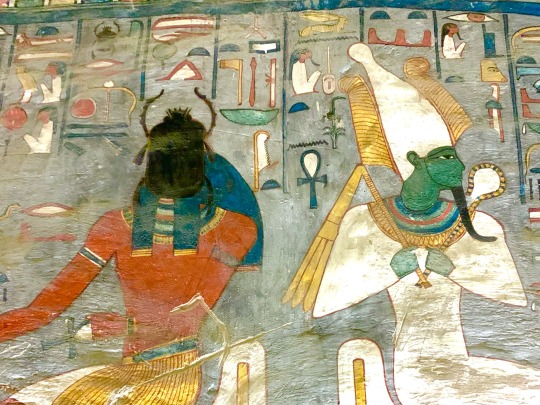
When pairs with opposing characteristics, like this, are brought together, they represent completeness. Egypt's myths are defined by themes of separation and return. After his father's death, Horus is exiled to the wilderness; harmony is only returned to the world after he himself returns, claims his birthright and unites the Two Lands. In the myth of Sekhmet, chaos reigns when she leaves behind her father, Ra, and roams about the world, slaughtering mankind. Harmony is restored when she returns to her father. In the Book of the Dead, the journey of the sun is characterised as one full of hazards, where he daily risks his boat being run ashore on a sandbank or being consumed by the serpent, Apophis, in the western horizon. When Ra returns to the western horizon and, in the night, is united with Osiris, he is at last rejuvenated and reborn again.
Separation and union.
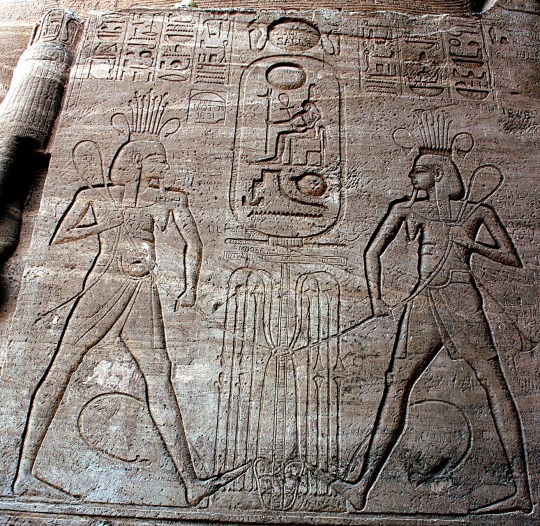
Separation and union were at the centre of Egyptian consciousness. In so many temples, you will see the symbol of unification. Here it is shown centrally with the cartouche of Ramesses above. It is usually flanked by a pair of gods. Here, both gods are Hapi, the personification of the Nile, but elsewhere, you will often see Horus juxtaposed with Seth. Such scenes reference an end to their fighting and the restoration of justice and stability to Egypt. In other versions of the motif, Thoth stands in for Seth. Thoth was a 'safe' option, since Seth was, at times, considered too dangerous a deity to depict. However, Thoth also forms a complementary pair with Horus because Thoth is a moon-god and Horus, a sun-god.
The idea at the heart of all these depictions is the union of opposing forces, resulting in the restoration of order and harmony (in Egyptian, 'maat').
#Egypt#egyptology#egyptian pharaoh#egyptian#ancient history#ancient egypt#pharaoh#Ra#Osiris#Khepri#Hapi#Kemet#Kemetic#Kemeticism#valley of the kings#Luxor temple#egyptian temple#tutankhamun#Ankhesenamun
7 notes
·
View notes